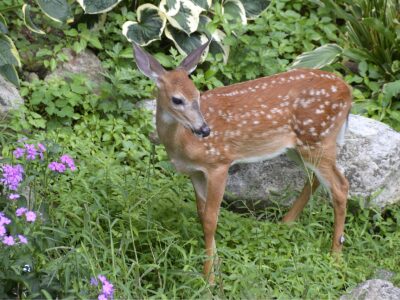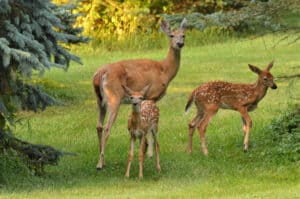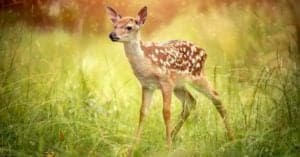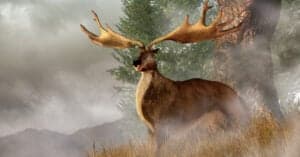The 10 Largest Deer in the World!
In the animal kingdom, there are many types of animals that have horns or antlers. Not all of these qualify as “deer.” An antelope, for example, is similar to a deer but occupies an entirely different scientific family. So, what is a deer?
A deer is a member of the Cervidae family of herbivorous mammals that share common characteristics like hooves and (aside from rare exceptions) the male growing antlers. Within the Cervidae family, there are numerous species (both living and extinct). Let’s take a look at the ten largest deer in the world!
Since antler size varies amongst the various species, calculating size falls on maximum observed weight per species (not average weight) and how high the shoulders are from the ground.
10. Pere David’s Deer (Elaphurus davidianus)
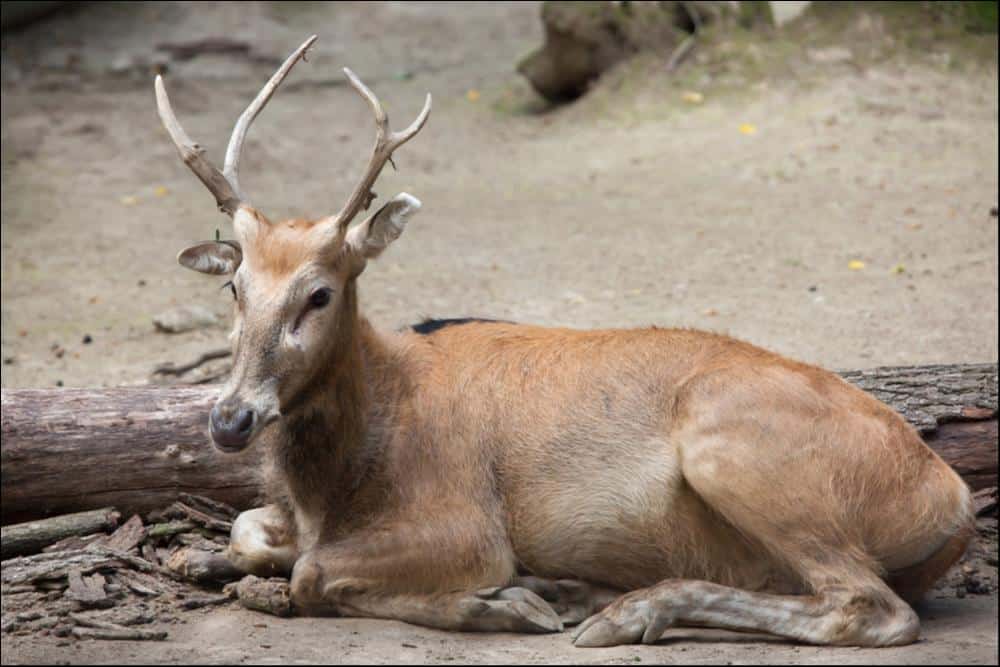
- Max Size: 441 lbs
- Height: 3.9 ft. from hoof to shoulder
Coming in at number 10 on our list, the Pere David’s deer is a large deer native to Asia. It is the only member of its genus and is no longer found in the wild. Captive populations in zoos, private animal collections, and game reserves constitute the last members of the species.
The deer is peculiar in appearance, with a horse’s head, antlers, a donkey’s tail, and hooves that resemble cow hooves with the added adaption of webbing between the toes (for swimming). They are resourceful animals as well, displaying the ability to use their hooves as tools for digging and scraping. In 2016, 16 deer were released into an unfenced park in China, tentatively meaning they are back in the wild. Their success will be determined by whether or not they can survive and produce viable offspring.
9. Mule Deer (Odocoileus hemionus)
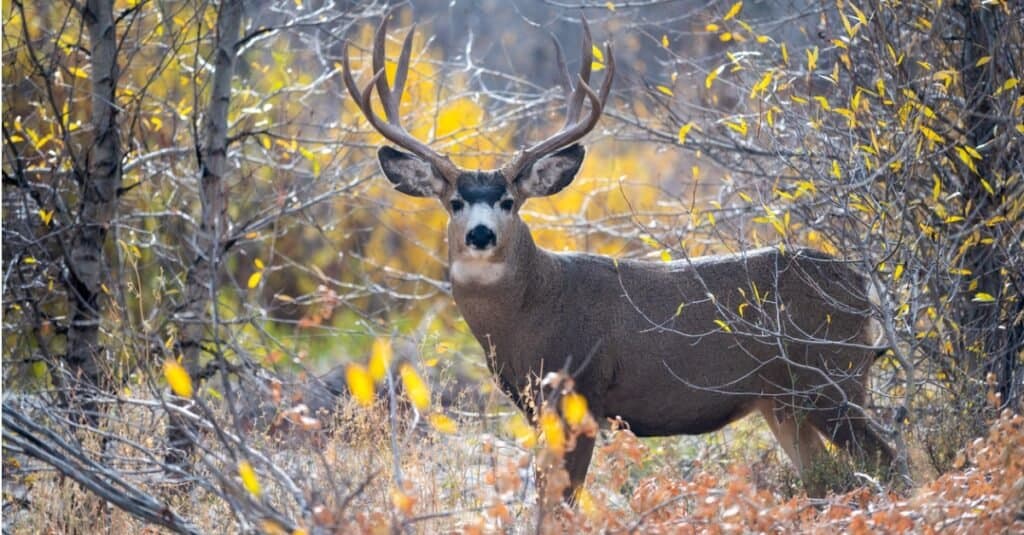
- Max Size: 463 lbs
- Height: 3.9 ft. from hoof to shoulder
Named for their large, mule-like ears, these gentle herbivores are among the most iconic examples of wildlife in the American West. Another defining characteristic is their tail, which is short, all-white, and has a small black tip. Once ultra-prominent amongst the western areas of North America, mule deer populations are declining. At one time, a herd of over 100,000 was observed in Colorado; the same herd is down to 32,000 members currently.
There are roughly 4 million mule deer spread across their range, with 10 valid subspecies. According to the IUCN, they are listed as least concern, but challenges like urban development and habitation fragmentation exist. Mule deer are hunted by humans but also experience predation from coyotes, mountain lions, eagles, bears, wolves, lynx, and bobcats.
8. Thorold’s Deer (Cervus albirostris)
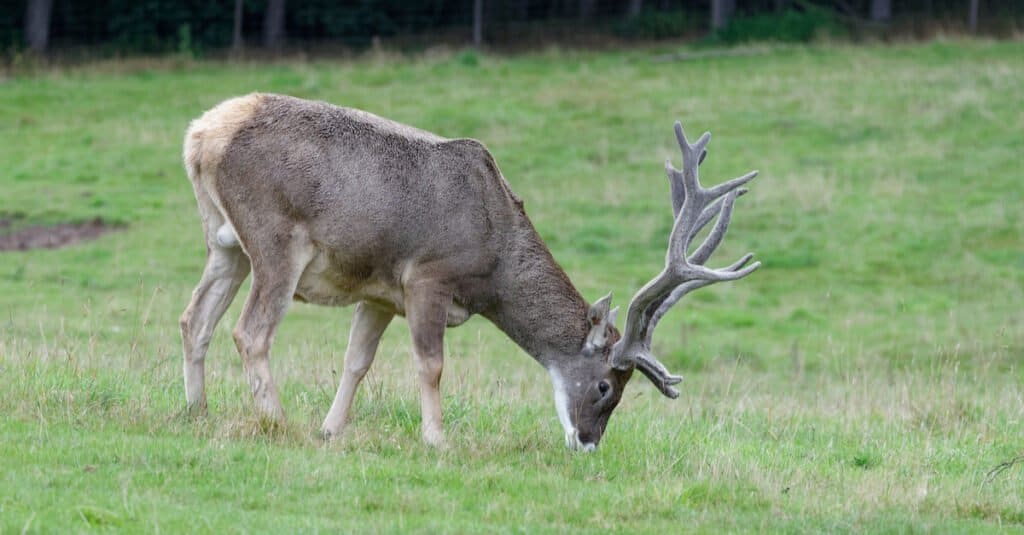
Martin Fowler/Shutterstock.com
- Max Size: 507 lbs
- Height: 4.6 ft. from hoof to shoulder
This threatened species lives at high altitudes on the eastern side of the Tibetan Plateau. They are also known as the Chinese white-lipped deer due to pronounced patches of white around their muzzle. The Latin species name albirostris, comes from the words albus (white) and rostrum (snout).
Thorold’s have a dark brown colored upper coat, and their eyes have distinct white-eye rings. Their antlers can be quite large and differ from other species because of their cream coloration. Overhunting has resulted in its current conservation status of vulnerable. Like many deer, Thorold’s deer is crepuscular, meaning they are more active during twilight.
7. White-tailed Deer (Odocoileus virginianus)

Paul Tessier/Shutterstock.com
- Max size: 512 lbs
- Height: 4 ft. from hoof to shoulder
The white-tailed deer is one of the most common deer species on earth. It has a wide natural range (North America, Central America, Ecuador, and part of South America) and has also been introduced in other areas like New Zealand, the Caribbean, and Europe. In the US state of Texas alone, some five million white-tailed deer are present.
White-tailed deer are one of the more skittish deer species, often swishing their tails back and forth when they are nervous. When confronted with danger, white-tails can run up to 30 mph and are adept swimmers, capable of making it across strong rivers and lakes to escape. Along with other deer types like the mule deer, chronic wasting disease (sometimes called zombie deer) has been observed in white-tail populations. An infected deer can suffer from drastic weight loss, stumbling, listlessness, and other neurological symptoms. To date, no infection has been transmitted to humans, but the prevalence of the disease has become a concern to hunters and conservationists alike.
6. Barasingha (Rucervus duvaucelii)
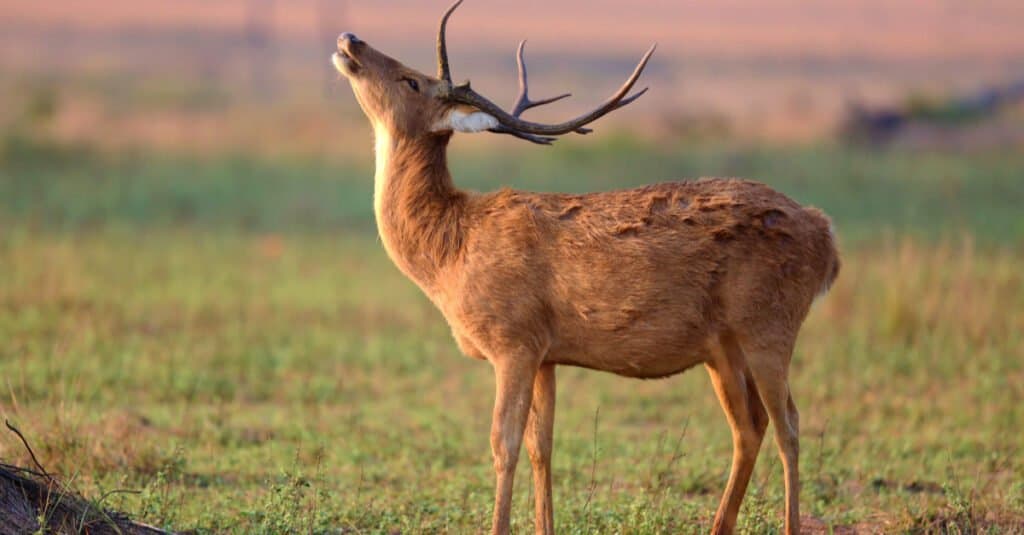
PhotocechCZ/Shutterstock.com
- Max size: 617 lbs
- Height: 4.3 ft. from hoof to shoulder
The barasingha (also known as the swamp deer) is a deer native to the Indian subcontinent. They have numerous tines (points/prongs) on their antlers, numbering anywhere from 14-20. The word barasingha means “12-horned” in Hindustani.
The barasingha has been the focus of a successful repopulation program, which began in 1967 when the total species population numbed only 66. The IUCN currently lists the barasingha as vulnerable. There are currently three identified subspecies, all occurring on the Indian subcontinent as well. Although repopulation efforts have been successful, the main threat to the longevity of the species is the conversion of wetlands to agriculture and urban development, which destroys the deer’s preferred habitat.
5. Reindeer (Rangifer tarandus)
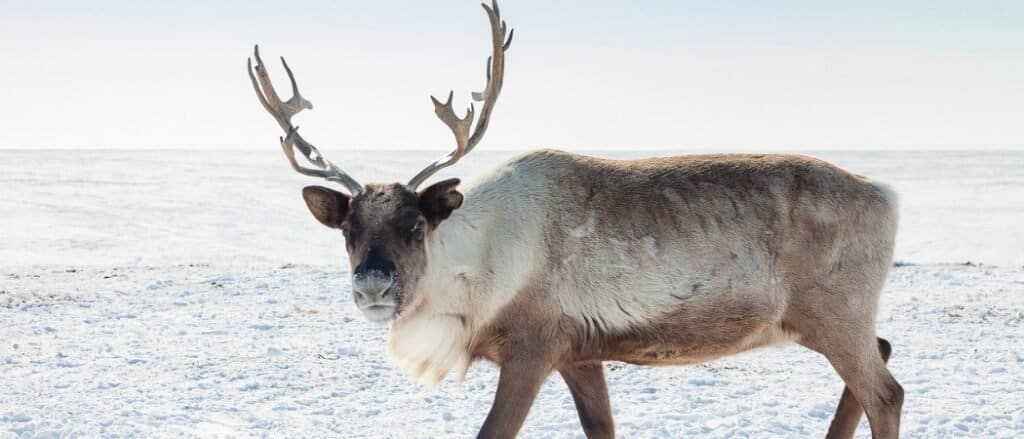
- Max size: 701 lbs
- Height: 4.9 ft. from hoof to shoulder
Just like that, we’re into the top five with the reindeer or caribou. They are arctic specialists, living in large quantities above the arctic circle in North America, Europe, Siberia, and Greenland. Generally speaking, there are two types, forest and tundra reindeer. The tundra reindeer migrate in enormous herds, sometimes totaling more than half a million members.
Some of the more prominent physical characteristics of reindeer include deeply cloven hooves for snow travel and enormous antlers, sometimes numbering up to 44 points. By some estimates, there are over 3.5 million reindeer in North America, around 1 million in Eurasia, and roughly 3 million domesticated reindeer in northern Europe. Nevertheless, Reindeer herds in the lower 48 US states have disappeared, and herd size in Canada is shrinking. This, coupled with habitat fragmentation and human interference, has caused the IUCN to list reindeer as a vulnerable species overall.
Domesticated reindeer have had a long history with humans living in the polar regions. Reindeer in northern Europe are important to the Saami, Swedes, Finns, Norwegians, Russians, and the Inuit in North America. They have been used to pull sleds, manage chores, and are still hunted by some for their fur, meat, and bones (which are then used to craft tools). Contrary to many other species, the domestication of reindeer has been going on since at least the bronze age, signifying more than a thousand years of companionship between humans and reindeer.
4. Red Deer (Cervus elaphus)
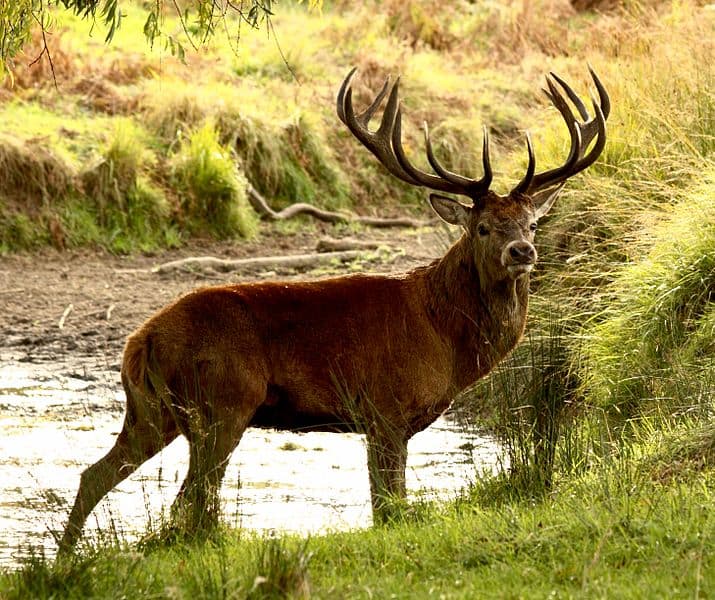
- Max size: 1,102 lbs
- Max height: 4.6 ft. from hoof to shoulder
Our first entry to have a maximum observed weight over one thousand pounds in a fully grown adult, the red deer is a big animal. This species is prominent in Europe, the Caucasus region, Turkey, and parts of Iran. There are even small numbers present in the tall Atlas Mountains of Northern Africa.
Red deer are often compared to elk in North America and share a common ancestor. Historically, elk were considered a subspecies of red deer, although recently, they have been given their own species categorization. Some consider the red deer to be a species group as opposed to one species, but there is much debate over how many individual species and subspecies are associated with the red. Overall, red deer populations are prominent and stable, with conditions differing per locale (decline in the Atlas Mt. population, for example).
3. Sambar (Rusa unicolor)
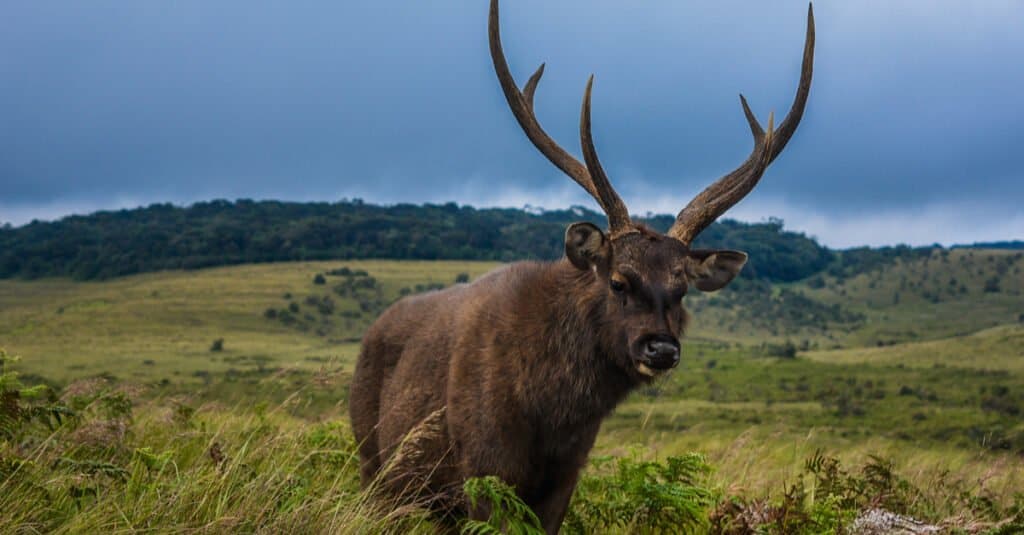
Swarna367/Shutterstock.com
- Max size: 1,204 lbs
- Height: 5.2 ft. from hoof to shoulder
The sambar is the largest deer species native to India and Southeast Asia. The appearance and size of each sambar can differ wildly, which has led to some classification confusion in the past. Generally speaking, they are large deer with antlers prevalent on the males and a long tail with a black tip, similar to the mule deer. The males tend to spar like other deer species, but they have been observed to stand on their hind legs and crash their antlers down, which is unique amongst deer and resembles the sparring techniques of bighorn sheep.
The sambar has been introduced in a few countries to varying degrees of success, including Australia, where it’s become quite a popular hunting prize. Currently, there are seven extant and one extinct subspecies. Conservation efforts are ongoing but vary wildly between locations; the IUCN lists the sambar as vulnerable.
2. Elk (Cervus canadensis)
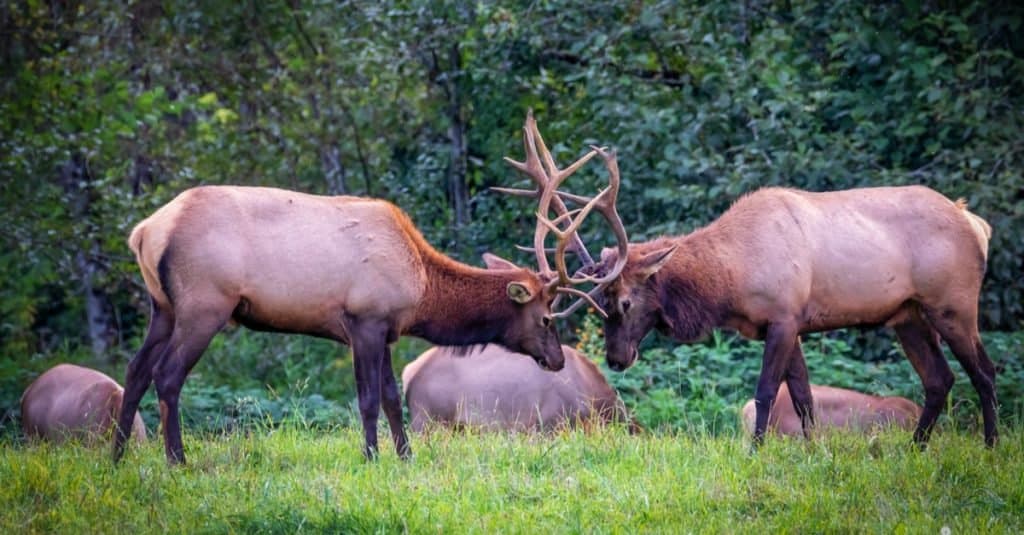
Mark A Lee/Shutterstock.com
- Max size: 1,323 lbs
- Height: 5.2 ft. from hoof to shoulder
This massive deer is a mainstay in many locations. Their rut (mating season), which occurs every autumn, is a tourist magnet in places like Estes Park, Colorado, drawing thousands of visitors every year. The males showcase their antlers, occasionally spar with other males, and let out a haunting bugle intended to attract females.
Elk are also called wapiti, which comes from the Shawnee and Cree Native American word “waapiti,” meaning white rump. In Europe, they are exclusively called wapiti, while moose are called elk. This geographic difference in phrasing can be traced back all the way to the 17th century.
Elk populations are largely stable, so they are listed as least concern, according to the IUCN. They were hunted to extinction in many areas, but large reintroduction efforts have been implemented over the last hundred years. There are roughly one million elk in North America.
1. Moose (Alces alces)
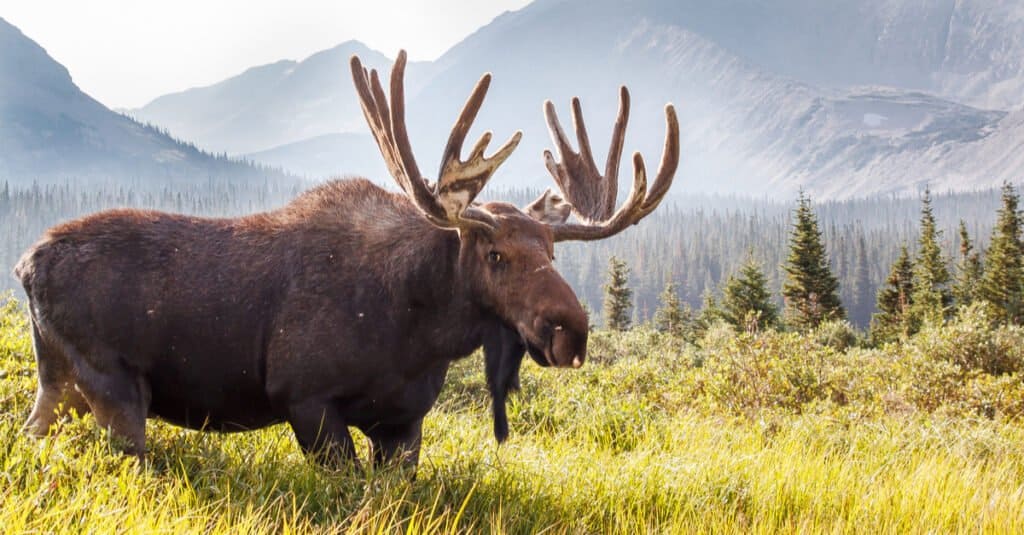
Michael Liggett/Shutterstock.com
The largest deer on earth is the moose (referred to as elk in Europe). Moose are enormous, featuring broad, open-palmed antlers with points extending beyond the “palm.” The largest ever recorded moose weighed 1,808 lbs!
Unlike most deer species, moose are largely solitary, except during the mating season. It is common to see solitary bull moose and either solitary females or females with one-two offspring. Their range in North America is large, extending from Alaska through Canada and the northeastern US. The Rocky Mountain Ranges also contain moose, with isolated populations occurring as far south as Colorado and Utah. European elk live in large numbers in Scandinavia, the Czech Republic, Ukraine, Belarus, and Russia.
Moose, while resembling deer in many ways, also have some identifiable differences. Both males and female moose have a dewlap, which is a fold of skin underneath the chin. Moose also shed their antlers every year and the size and symmetry of the antlers reflect the overall health of the moose. Moose also have a really big, bulky nose. Their large nose acts like our eyes, but where our eyes take in a field of vision to process, a moose’s nose takes in an array of smells and processes them; consequently, moose have a fantastic sense of smell. Their nostrils can also close, which allows them to forage for aquatic food. Like other deer, they are adept swimmers and can even submerge down to five meters below the surface if they so choose.
While a pack of hungry wolves could take a moose down, and moose calves have become victims to the occasional bear, it’s the Siberian Tiger that represents the most direct predator to the moose. Their ranges overlap in one part of Russia, north of the city of Vladivostock and near the Pacific, where the tiger hunts moose regularly. In another strange overlapping of habitats, moose swimming in deep channels between islands off of North America’s northwest coast have been killed and eaten by hungry orcas, meaning moose in that area have a natural marine predator. In most places where moose are common, however, they enjoy less predation than other similar species because of their enormous size.
The Largest Deer That Ever Lived

Daniel Eskridge/Shutterstock.com
Deer have been around for a long time, and the current extant species do not account for the massive deer of the past. The Irish elk (resembling a North American moose but genetically dissimilar) was the largest deer to ever walk the earth. While extinct, fossils indicate the Irish elk was on par with the Alaskan moose in terms of size and most likely weighted more, up to nearly 2,000 lbs. The Irish elk went extinct roughly 8,000 years ago.
The Smallest Deer: The Northern Pudu
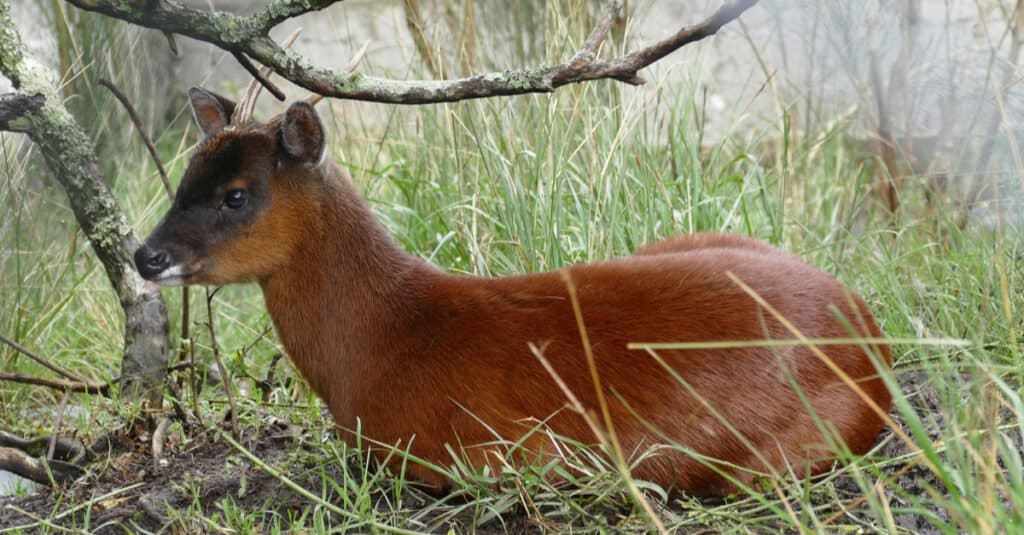
Helge Zabka/Shutterstock.com
Before we get to the largest members of the deer, let’s take a look at the smallest one. The northern pudu, a native of the Andes mountains in Columbia, Ecuador, and Peru, weighs in at roughly 13 pounds when fully grown. A Northern Pudu’s shoulders stand a little more than a foot off the ground, and their total length from head to tail is a little more than two and a half feet.
More from A-Z Animals
In the animal kingdom, there are many types of animals that have horns or antlers. Not all of these qualify as “deer.” An antelope, for example, is similar to a deer but occupies an entirely different scientific family. So, what is a deer?
A deer is a member of the Cervidae family of herbivorous mammals that share common characteristics like hooves and (aside from rare exceptions) the male growing antlers. Within the Cervidae family, there are numerous species (both living and extinct). Let’s take a look at the ten largest deer in the world!
Since antler size varies amongst the various species, calculating size falls on maximum observed weight per species (not average weight) and how high the shoulders are from the ground.
10. Pere David’s Deer (Elaphurus davidianus)

- Max Size: 441 lbs
- Height: 3.9 ft. from hoof to shoulder
Coming in at number 10 on our list, the Pere David’s deer is a large deer native to Asia. It is the only member of its genus and is no longer found in the wild. Captive populations in zoos, private animal collections, and game reserves constitute the last members of the species.
The deer is peculiar in appearance, with a horse’s head, antlers, a donkey’s tail, and hooves that resemble cow hooves with the added adaption of webbing between the toes (for swimming). They are resourceful animals as well, displaying the ability to use their hooves as tools for digging and scraping. In 2016, 16 deer were released into an unfenced park in China, tentatively meaning they are back in the wild. Their success will be determined by whether or not they can survive and produce viable offspring.
9. Mule Deer (Odocoileus hemionus)

- Max Size: 463 lbs
- Height: 3.9 ft. from hoof to shoulder
Named for their large, mule-like ears, these gentle herbivores are among the most iconic examples of wildlife in the American West. Another defining characteristic is their tail, which is short, all-white, and has a small black tip. Once ultra-prominent amongst the western areas of North America, mule deer populations are declining. At one time, a herd of over 100,000 was observed in Colorado; the same herd is down to 32,000 members currently.
There are roughly 4 million mule deer spread across their range, with 10 valid subspecies. According to the IUCN, they are listed as least concern, but challenges like urban development and habitation fragmentation exist. Mule deer are hunted by humans but also experience predation from coyotes, mountain lions, eagles, bears, wolves, lynx, and bobcats.
8. Thorold’s Deer (Cervus albirostris)

Martin Fowler/Shutterstock.com
- Max Size: 507 lbs
- Height: 4.6 ft. from hoof to shoulder
This threatened species lives at high altitudes on the eastern side of the Tibetan Plateau. They are also known as the Chinese white-lipped deer due to pronounced patches of white around their muzzle. The Latin species name albirostris, comes from the words albus (white) and rostrum (snout).
Thorold’s have a dark brown colored upper coat, and their eyes have distinct white-eye rings. Their antlers can be quite large and differ from other species because of their cream coloration. Overhunting has resulted in its current conservation status of vulnerable. Like many deer, Thorold’s deer is crepuscular, meaning they are more active during twilight.
7. White-tailed Deer (Odocoileus virginianus)

Paul Tessier/Shutterstock.com
- Max size: 512 lbs
- Height: 4 ft. from hoof to shoulder
The white-tailed deer is one of the most common deer species on earth. It has a wide natural range (North America, Central America, Ecuador, and part of South America) and has also been introduced in other areas like New Zealand, the Caribbean, and Europe. In the US state of Texas alone, some five million white-tailed deer are present.
White-tailed deer are one of the more skittish deer species, often swishing their tails back and forth when they are nervous. When confronted with danger, white-tails can run up to 30 mph and are adept swimmers, capable of making it across strong rivers and lakes to escape. Along with other deer types like the mule deer, chronic wasting disease (sometimes called zombie deer) has been observed in white-tail populations. An infected deer can suffer from drastic weight loss, stumbling, listlessness, and other neurological symptoms. To date, no infection has been transmitted to humans, but the prevalence of the disease has become a concern to hunters and conservationists alike.
6. Barasingha (Rucervus duvaucelii)

PhotocechCZ/Shutterstock.com
- Max size: 617 lbs
- Height: 4.3 ft. from hoof to shoulder
The barasingha (also known as the swamp deer) is a deer native to the Indian subcontinent. They have numerous tines (points/prongs) on their antlers, numbering anywhere from 14-20. The word barasingha means “12-horned” in Hindustani.
The barasingha has been the focus of a successful repopulation program, which began in 1967 when the total species population numbed only 66. The IUCN currently lists the barasingha as vulnerable. There are currently three identified subspecies, all occurring on the Indian subcontinent as well. Although repopulation efforts have been successful, the main threat to the longevity of the species is the conversion of wetlands to agriculture and urban development, which destroys the deer’s preferred habitat.
5. Reindeer (Rangifer tarandus)

- Max size: 701 lbs
- Height: 4.9 ft. from hoof to shoulder
Just like that, we’re into the top five with the reindeer or caribou. They are arctic specialists, living in large quantities above the arctic circle in North America, Europe, Siberia, and Greenland. Generally speaking, there are two types, forest and tundra reindeer. The tundra reindeer migrate in enormous herds, sometimes totaling more than half a million members.
Some of the more prominent physical characteristics of reindeer include deeply cloven hooves for snow travel and enormous antlers, sometimes numbering up to 44 points. By some estimates, there are over 3.5 million reindeer in North America, around 1 million in Eurasia, and roughly 3 million domesticated reindeer in northern Europe. Nevertheless, Reindeer herds in the lower 48 US states have disappeared, and herd size in Canada is shrinking. This, coupled with habitat fragmentation and human interference, has caused the IUCN to list reindeer as a vulnerable species overall.
Domesticated reindeer have had a long history with humans living in the polar regions. Reindeer in northern Europe are important to the Saami, Swedes, Finns, Norwegians, Russians, and the Inuit in North America. They have been used to pull sleds, manage chores, and are still hunted by some for their fur, meat, and bones (which are then used to craft tools). Contrary to many other species, the domestication of reindeer has been going on since at least the bronze age, signifying more than a thousand years of companionship between humans and reindeer.
4. Red Deer (Cervus elaphus)

- Max size: 1,102 lbs
- Max height: 4.6 ft. from hoof to shoulder
Our first entry to have a maximum observed weight over one thousand pounds in a fully grown adult, the red deer is a big animal. This species is prominent in Europe, the Caucasus region, Turkey, and parts of Iran. There are even small numbers present in the tall Atlas Mountains of Northern Africa.
Red deer are often compared to elk in North America and share a common ancestor. Historically, elk were considered a subspecies of red deer, although recently, they have been given their own species categorization. Some consider the red deer to be a species group as opposed to one species, but there is much debate over how many individual species and subspecies are associated with the red. Overall, red deer populations are prominent and stable, with conditions differing per locale (decline in the Atlas Mt. population, for example).
3. Sambar (Rusa unicolor)

Swarna367/Shutterstock.com
- Max size: 1,204 lbs
- Height: 5.2 ft. from hoof to shoulder
The sambar is the largest deer species native to India and Southeast Asia. The appearance and size of each sambar can differ wildly, which has led to some classification confusion in the past. Generally speaking, they are large deer with antlers prevalent on the males and a long tail with a black tip, similar to the mule deer. The males tend to spar like other deer species, but they have been observed to stand on their hind legs and crash their antlers down, which is unique amongst deer and resembles the sparring techniques of bighorn sheep.
The sambar has been introduced in a few countries to varying degrees of success, including Australia, where it’s become quite a popular hunting prize. Currently, there are seven extant and one extinct subspecies. Conservation efforts are ongoing but vary wildly between locations; the IUCN lists the sambar as vulnerable.
2. Elk (Cervus canadensis)

Mark A Lee/Shutterstock.com
- Max size: 1,323 lbs
- Height: 5.2 ft. from hoof to shoulder
This massive deer is a mainstay in many locations. Their rut (mating season), which occurs every autumn, is a tourist magnet in places like Estes Park, Colorado, drawing thousands of visitors every year. The males showcase their antlers, occasionally spar with other males, and let out a haunting bugle intended to attract females.
Elk are also called wapiti, which comes from the Shawnee and Cree Native American word “waapiti,” meaning white rump. In Europe, they are exclusively called wapiti, while moose are called elk. This geographic difference in phrasing can be traced back all the way to the 17th century.
Elk populations are largely stable, so they are listed as least concern, according to the IUCN. They were hunted to extinction in many areas, but large reintroduction efforts have been implemented over the last hundred years. There are roughly one million elk in North America.
1. Moose (Alces alces)

Michael Liggett/Shutterstock.com
The largest deer on earth is the moose (referred to as elk in Europe). Moose are enormous, featuring broad, open-palmed antlers with points extending beyond the “palm.” The largest ever recorded moose weighed 1,808 lbs!
Unlike most deer species, moose are largely solitary, except during the mating season. It is common to see solitary bull moose and either solitary females or females with one-two offspring. Their range in North America is large, extending from Alaska through Canada and the northeastern US. The Rocky Mountain Ranges also contain moose, with isolated populations occurring as far south as Colorado and Utah. European elk live in large numbers in Scandinavia, the Czech Republic, Ukraine, Belarus, and Russia.
Moose, while resembling deer in many ways, also have some identifiable differences. Both males and female moose have a dewlap, which is a fold of skin underneath the chin. Moose also shed their antlers every year and the size and symmetry of the antlers reflect the overall health of the moose. Moose also have a really big, bulky nose. Their large nose acts like our eyes, but where our eyes take in a field of vision to process, a moose’s nose takes in an array of smells and processes them; consequently, moose have a fantastic sense of smell. Their nostrils can also close, which allows them to forage for aquatic food. Like other deer, they are adept swimmers and can even submerge down to five meters below the surface if they so choose.
While a pack of hungry wolves could take a moose down, and moose calves have become victims to the occasional bear, it’s the Siberian Tiger that represents the most direct predator to the moose. Their ranges overlap in one part of Russia, north of the city of Vladivostock and near the Pacific, where the tiger hunts moose regularly. In another strange overlapping of habitats, moose swimming in deep channels between islands off of North America’s northwest coast have been killed and eaten by hungry orcas, meaning moose in that area have a natural marine predator. In most places where moose are common, however, they enjoy less predation than other similar species because of their enormous size.
The Largest Deer That Ever Lived

Daniel Eskridge/Shutterstock.com
Deer have been around for a long time, and the current extant species do not account for the massive deer of the past. The Irish elk (resembling a North American moose but genetically dissimilar) was the largest deer to ever walk the earth. While extinct, fossils indicate the Irish elk was on par with the Alaskan moose in terms of size and most likely weighted more, up to nearly 2,000 lbs. The Irish elk went extinct roughly 8,000 years ago.
The Smallest Deer: The Northern Pudu

Helge Zabka/Shutterstock.com
Before we get to the largest members of the deer, let’s take a look at the smallest one. The northern pudu, a native of the Andes mountains in Columbia, Ecuador, and Peru, weighs in at roughly 13 pounds when fully grown. A Northern Pudu’s shoulders stand a little more than a foot off the ground, and their total length from head to tail is a little more than two and a half feet.

